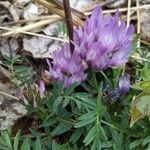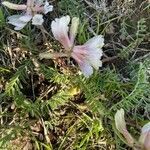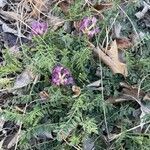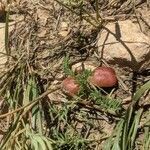Stems clustered on a stout taproot and caudex, 1–6 dm, decumbent with ascending tip, strigose; stipules 3–10 mm; lfls 15–29, oblanceolate to elliptic, 8–15 mm, appressed-hairy on both sides or glabrous above; fls 17–25 mm; cal-tube 6–8 mm; fr subglobose, abruptly pointed, indehiscent, glabrous, bilocular, the walls 2–5 mm thick at maturity;2n=22. Prairies and plains; Apr., May. Var. crassicarpus, with purple fls, with the pubescence of the cal appressed or ascending, partly or wholly of black hairs, and with the fr 1.5–2.5 cm, occurs from Wis. to Alta., s. to n. Mo., Okla., Tex., and N.M. (Geoprumnon c.; Astragalus caryocarpus) Var. trichocalyx (Nutt.) Barneby, with ochroleucous fls (sometimes purple-tipped), with the cal densely villous-tomentulose, and with frs 2.5–3 cm, occurs from c. Ill. to Mo., Ark., Okla., and Tex. (Geoprumnon t.; Astragalus mexicanus, misapplied) Three other vars. are more western.
More
A herb. It grows 50 cm tall. It is a bean plant that keeps growing from year to year. The stems lie along the ground and it forms mats. It has branches near the base. The leaves are compound with 17-25 leaflets. They are oblong. They are smooth above and hairy underneath. The flowers are yellowish-white with a purple tinged keel. They are 2 cm long. Several flowers occur in loose clusters. The fruit are reddish fleshy pods. They are round and 2 cm across.
Prairies and plains. Dry rocky or gravelly prairies, slight slopes in clearing of woods, disturbed sites such as roadsides, in partial sun and is most abundant on limestone or clay soils; at elevations from 150-1,800 metres..
More
It is a temperate plant. It grows in open prairie and dry grassy hillsides. It grows in hardiness zones 3-8.





